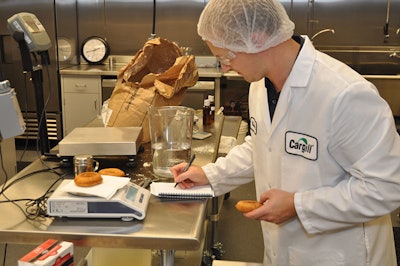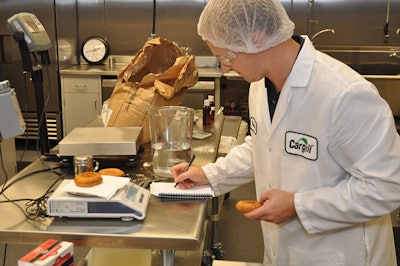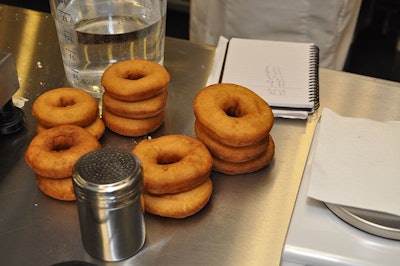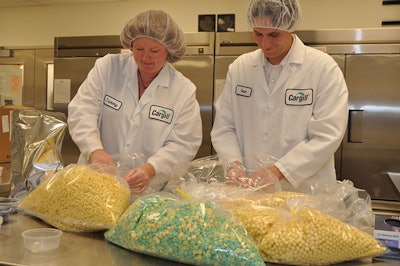

The simple, brick exterior stands in contrast to the complex and highly involved nature of what takes place inside the Cargill Food Innovation Center.
A walk down many of the hallways inside the 40,000-square-foot building in Plymouth, Minn., however, provides some specifics as to the facility’s mission — and results. Affixed to the walls of many of those hallways is signage and photos that illustrate some of the many success stories that have been authored due to the work that takes place just outside Minneapolis:
Improving nutritional profiles. To help reduce saturated fat and minimize trans-fat for its iconic french fry, a foodservice customer relied on Cargill to help reformulate its frying oils.
Solving complex formulation challenges. Cargill reformulated a popular ready-to-eat meat snack to help our customer achieve its cost management, sodium reduction and sensory goals.
Utilizing emerging technology. Cargill developed a new oil system to help our customer reduce saturated fat and improve the consistency of a popular cookie.
Sustaining the bottom line. Cargill helped a foodservice operator reformulate its popular meatball to increase yield, optimize costs and maintain protein levels while maintaining taste and texture.
Improving the market. Cargill helped accelerate customer development of a kid-friendly muffin to meet USDA’s School Lunch Program nutritional requirements.
Mitigating price risk. Cargill developed stabilizers to help yogurt manufacturers manage gelatin price volatility.
Those snapshots span many of the food categories in Cargill’s areas of expertise — snacks, cereals, bakery, confectionery, convenience, and frying applications — and showcase the ways the company assists its customers with research and development capabilities in a collaborative environment at the CFIC.
“This center is focused on our customers,” Cargill Director of Food Applications John Sweeney told Food Manufacturing during a recent visit to the CFIC. “We call it the Cargill Food Innovation Center, but it’s really taking out Cargill’s ideas and bringing it to the customer, and welcoming the customer into the (CFIC) and saying, ‘Come here and partner with us, we think we have a lot to offer … come in and work with us and let’s create and innovate and bring ideas to the market.’
“And that’s what’s exciting about it. Over time we have improved our capabilities, we’ve improved our knowledge, we have a better understanding of how our ingredients work in these applications and so we feel like it’s a team — and we’re getting better. We feel like we’ve made a lot of progress. And it’s an exciting time for Cargill because there are lots of challenges out there that need ingredient solutions that our customers repeatedly say to us, ‘We need you to help us with our supply chain challenges, with our sustainability challenges, with our flavor, taste, texture challenges.’
“I’ve been working for Cargill for a long time, and it’s exciting to see us start to realize that and help the customer and partner with them.”
Cargill touts the CFIC’s ability to help customers: develop new ingredient systems and components; rapidly deliver on concepts, mock-up and prototypes; provide culinary-based applications offering unique visual, taste and texture appeal; develop and scale up solutions, such as ingredient systems or finished products, and assist with process development and shelf-life testing; create an integrated supply chain program by drawing upon our capabilities in sourcing ingredients and relationships with co-manufacturers and co-packers; and solve specific formulation and reformulation challenges, including developing healthier food products.
Sweeney said the CFIC, which has a staff of 55 food scientists and ingredient developers focused on oils and shortenings, texturizing solutions and bakery/snacks/cereal applications, works on 150-200 projects in a given year, although the scope of those projects varies — sometimes significantly.
“Some of these are big, complex, difficult projects and some are what we call quick-turn projects — the customer has a request, can you help me with (a solution), we get a project brief and it’s really about speed,” Sweeney said. “Sometimes it’s complex and difficult, and we’ve got to spend the time to resolve it. Sometimes it’s, ‘Hey, I need to know how to reduce my salt in this product.’ And we hopefully have done our homework and have a solution ready to go, in which case it’s really getting them up and running with that idea.”
And in many cases, it is a collaborative effort between Cargill experts and the customer personnel inside the CFIC, a dynamic that Sweeney said many of Cargill’s competitors are not able to offer. Sweeney said the number of instances of in-facility collaboration is growing.
“We’ve had some big customers come in and say to us, ‘You know what, in a week here we got through what would have taken us months to do before.’ And when you think about it, that’s absolutely correct, because by the time we would do something and send it to them, and they would taste it and do something and send it back to us, like we used to work maybe 10 years ago, so much time passes. When we can get (customers) in here and get that energy and teamwork that happens side-by-side, and then that exchange of ideas that happens with people working side-by-side, it’s night and day a better way,” Sweeney said. “And that is something that we frequently say to our customers — would you be willing to come here — and what we’re seeing is more and more are coming here.
“I would say there’s two types (of customers) — there’s the ones that come here and it’s really let’s talk about our capabilities, let’s identify some projects, let’s see how we work. But then there are others who come and they are like, ‘OK, I’m good with all that, let’s get in here and get to work.’ And we’re trying to track both of those, and we’re seeing both of them increase, but certainly the one of working together in the labs collaboratively is really taking off. And this center has been a big part of that.”
The CFIC has specifically been a boon for food and beverage companies that have limited research and development capabilities/resources. Via its capabilities at the CFIC, Cargill is able to provide customers with product line and brand innovation toward a goal of generating market share and earnings growth, reduce product development cycles and improve access to global market insights and technologies. That’s achieved by Cargill’s ability to bring consumer, category and competitive perspectives and insights to bear; an ability to augment customer technical resources; an ability to help its customers realized the benefit of emerging technologies and processes; and its sensory capabilities.
“This is about taking ideas through a process forward to where it becomes a product in the market. This center is all about following the product development process from ideas through to working on the benchtop, then working in the piloting stage where we can hopefully duplicate some of our customers’ processes and then help them if they need it to go further into that launch cycle,” Sweeney said. “As you walk around here today, you’ll see that that’s really how we’ve laid out the building — in a way that it’s easy for us to work with them in those different stages to bring these ideas to life. That’s what innovation is all about and we’re trying to get better, faster, quicker at it, and continue to work on it.”

The CFIC at a Glance
The CFIC underwent a significant expansion that was completed in the summer of 2014. The $5.5 million project involved a complete remodeling of the facility, and doubled the size of the CFIC to the current 40,000 square-feet dimension. The expansion also allowed for Cargill to bring the majority of its food and ingredient and research staff under one roof.
Here is a closer look at the specific areas/labs inside the CFIC:
Culinary Kitchen/Collaboration and Presentation Space: This space combines high tech conference room equipment (LCD TV, audio system, etc.), with a restaurant environment and high-end restaurant kitchen to provide effective and complex support during customer visits. One of many unique features is a “plug and play” area in the chef kitchen area that provides flexibility of bringing project, application and customer equipment for each event. “This space is designed to be a fun, interactive space for chefs to work together,” Sweeney said. “Often when developing a menu for their restaurant, the Cargill chefs work side to side with the customer chef to create and taste together. The room has the audiovisual equipment needed to do a culinary demonstration for a larger online team as well. The Culinary kitchen brings together the art and science of food innovation.”
Sensory Evaluation Center: The sensory space is designed to conduct different sensory panels such as Descriptive Analysis or Difference Testing. Cargill Food Applications North America has trained panelists (14-16) on call who are specialized in Descriptive Analysis (QDA-Quantitative Descriptive Analysis and Spectrum). The Descriptive Analysis Panel works with variety of projects for different product categories such as sweeteners, beverages, baked goods, snacks, dairy and meat. Booths are adjacent to a panel training room and panelists have direct access to the booths after the training sessions. Sensory booths are equipped with laptops that panelists use to enter data when evaluating samples. SIMS Sensory Software is used for sensory test design, and data collection.
Frying Applications Lab: The lab is designed and equipped to support innovations in frying. Applications include flavor and functional attributes of ingredients for coating fried foods. In addition, multifactorial design frying studies are conducted in an R&D dedicated area of the lab to support development of market-forward innovations. “This lab allows us to take frying oil development to a new level,” Diliara Iassonova, Innovation Development Leader for Cargill Oils & Shortenings, said. “With an extensive collection of frying equipment, direct access to the sensory area and analytical lab support, we study and offer to our customers solutions designed and tested on customer-specific food products, fryer systems and frying practices.”
Ingredient Development Lab: This area is for bench-scale fats and oils prototypes development and evaluation. Capabilities support product development process for systems like cake icing and shortening, topical oil applications (spraying and coating), and spreads. Texture, color, moisture and viscosity are typically evaluated, as well as accelerated oxidative stability and shelf life tests.
Oil Processing Lab: Dedicated to the creation of modified fats and oils products such as interesterified shortenings, and evaluation of oil processing parameters from seed or crude oil to the final steps of oil refining like steam deodorization and molecular distillation. “This is the area where we develop new-to-the-world oils,” Iassonova said.
Oil Analytical Lab: This lab includes extensive analytical capability to cover a full spectrum of analytical support for oils and fats R&D, from basic oil stability tests and frying oil degradation products characterization, to complex compositional and elemental analysis.
Snacks and Cereal Applications and Pilot Applications: The Snacks and Cereal Lab is dedicated to optimizing formulations and test ingredients on the benchtop for snacks, cereal, and confectionery and convenience applications. The Snacks and Cereal Pilot Lab is dedicated to the scaling up of bench concepts to better replicate production environment. This is accomplished by testing with increased batch size and under the duress of different processing conditions to verify the feasibility of the original formula in continuous process.
Customer Innovation Kitchen: This space allows CFIC staff to work side-by-side with customers to develop and scale up customer solutions, process development and shelf-life testing. “Occasionally the customer wants some privacy to work on their secret recipe or next big idea,” Sweeney said. “In this case the Innovation Kitchen can be isolated from the rest of the facility so that the customer can be confident that their need for confidentiality will be respected.”
Bakery Applications: Devoted to developing new bakery ingredient technologies focused on innovation, providing healthier formulations, optimizing customer formulations, prototyping new concepts, optimizing formulations and improving time to market. The bakery team has experience with traditional baked goods such as breads, cakes, cookies, muffins, tortillas, pizza and more.
Analytical: Conducts the most frequently utilized tests for food applications, including rheology/viscosity, texture, pH, moisture, volume, and cell structure by all groups in the CFIC.

Staying on Top of Trends in an Evolving Marketplace
One of the CFIC’s greatest strengths, according to Sweeney, is its ability to help customers quickly adapt to changing trends in the ever-evolving food industry. And there are several areas of focus that are becoming more common when it comes to solutions sought by Cargill’s customers.
Clean-label initiatives have been an expanding area of emphasis, and CFIC experts have worked with customers to provide more label-friendly options across a number of product segments. Sodium-reduction projects are another growing area, along with texturizing solutions. But one of the biggest trends the industry is seeing right now revolves around sugar reduction and reduced-sugar products, according to Sweeney.
“What we’re seeing across the space is people are looking for ways to reduce sugar,” Sweeney said. “That certainly has happened, but also they’re looking for different options than maybe in the past where the mindset has been, ‘I have to have this much sugar in this product, and if I’m looking to replace that sugar I need to compare my solution to that full sugar (product).’
“I think what we’re starting to realize is that consumers’ tastes are changing and maybe they’ll be able to like something that’s actually less sweet than it was in the past … Which is a radical change from where we’ve been.”
Some projects, meanwhile, can come on more quickly and become a larger scale focus, particularly when supply chain issues arise or there is price volatility in a specific ingredients market. Last year’s bird flu epidemic, for instance, put a serious crimp in the egg supply and resulted in record-high egg prices. Cargill was able to work with its customers on egg replacement solutions, and currently has three ingredients available for replacing eggs in bakery products.
“When (avian flu) hit, people are not only on the one hand needing egg supply because it got very tight, but on the other hand, we were able to step forward and say that we can help you with egg replacement because our texturizer business can help you with that. And as the price of egg products just went through the roof, we just saw a huge response out of the industry with people wanting help with that,” Sweeney said.
Not long after Food Manufacturing’s visit, Cargill issued a news release highlighting its most recent label-friendly solution stemming from the baking and sensory work done at the CFIC:
MINNEAPOLIS – JAN. 6, 2016 – Following the FDA’s 2015 ruling on partially hydrogenated oils (PHO), Cargill Texturizing Solutions is offering bread manufacturers a successful replacement for monoglycerides and DATEM, which are sometimes made from PHO.
With consumer and customer pressures growing around “label-friendly ingredients,” Cargill has worked to find replacements that consumers will embrace. Liquid and de-oiled soy lecithin came out on top.
Cargill developed its solution even before the FDA’s move to revoke GRAS status for PHO mid-2015, which also had repercussions for monoglycerides and DATEM, emulsifiers widely used in bakeries as dough strengtheners, volume increasers and crumb softeners. Cargill’s unmodified soy lecithin products replicate those characteristics in a cost-effective manner and give customers a ready-to-go workaround.
“For the last year we have done extensive testing with multiple solutions to offer a replacement for our customers,” said Cargill Master Baker Bill Gilbert. “We’ve worked on processing, texture profile analysis, moisture and had trained sensory panelists evaluate them for 21-day shelf life breads.”
Special efforts were made to come up with a “label-friendly” solution, said Marketing Manager Kathrine Lutz. “The team tested multiple alternatives that could work functionally, but unmodified soy lecithin provided the best solution. In the end, we found it.”
Confident in his test results, Gilbert said Cargill’s solution has proven results. “At a time when manufacturers are faced with rapidly changing market dynamics and lack of R&D resources, Cargill is here to help.”
And it’s safe to say there is plenty more innovation on the way at the CFIC.
“This is fun. We have a fun job. It’s energizing, we’re creating solutions, it’s great to see those solutions get out into the market and see a return on Cargill’s investment,” Sweeney said. “We like our jobs here, they’re engaging and we’ve come a long way to have what I think are world-class capabilities.”























